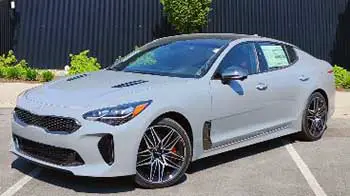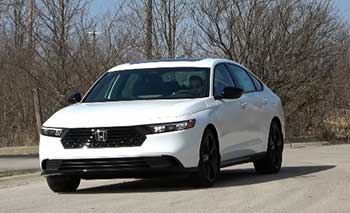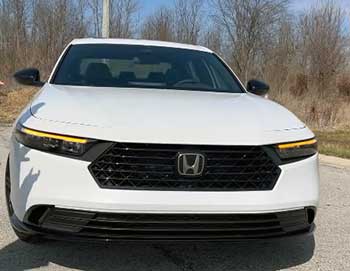I’ve always been fascinated by midsize sedans that balance performance, comfort, and practicality. Recently, I set out to compare two standout contenders: the Kia Stinger and the Honda Accord. My goal? To help you decide which car fits your driving style and lifestyle by sharing my firsthand insights. This article breaks down their pros and cons, key features, and real-world appeal in a detailed, engaging way. Whether you’re chasing thrills or prioritizing efficiency, I’ve got you covered with a clear comparison to guide your choice.
Comparison Table of Kia Stinger vs. Honda Accord
| Feature | Kia Stinger | Honda Accord |
| Base Price (MSRP) | $37,865 | $29,445 |
| Engine Options | 2.5L Turbo 4-cylinder (300 hp), 3.3L V6 Twin-Turbo (368 hp) | 1.5L Turbo 4-cylinder (192 hp), 2.0L Turbo 4-cylinder (252 hp) |
| Fuel Economy (City/Highway) | 22/32 MPG (2.5L), 17/25 MPG (V6) | 29/37 MPG (1.5L), 22/32 MPG (2.0L) |
| Drivetrain | RWD (AWD optional) | FWD |
| Cargo Space | 23.3 cu. ft. (hatchback) | 16.7 cu. ft. (trunk) |
| Rear Legroom | 36.4 inches | 40.8 inches |
| Safety Rating (NHTSA) | 5 Stars | 5 Stars |
| Infotainment | 10.25-inch touchscreen, Apple CarPlay, Android Auto | 8-inch or 12.3-inch touchscreen, Apple CarPlay, Android Auto |
| Standard Features | Leather seats, 9-speaker audio, LED headlamps | Cloth seats, 4-speaker audio, LED headlamps |
| Reliability (iSeeCars) | 7.0/10 | 9.3/10 |
| Resale Value (5-Year Depreciation) | 43.1% | 31.5% |
| 0-60 MPH (Base Engine) | 6.1 seconds (2.5L) | 7.2 seconds (1.5L) |
My Journey with Midsize Sedans
Midsize sedans have always held a special place in my heart. They’re the Goldilocks of cars. They are not too big, not too small. They often blend practicality with just enough flair to keep things exciting.
Over the years, I’ve driven everything from zippy compacts to lumbering SUVs. But sedans like the Kia Stinger and Honda Accord stand out. This is for their ability to cater to both my practical side and my inner car enthusiast. The Stinger, with its bold design and sporty edge, feels like a dare to have fun. Meanwhile, the Accord’s reputation for reliability and comfort screams dependability.
I’ve spent time behind the wheel of both. I’ve woven through city streets and cruised highways. This is to understand what makes each tick. This comparison stems from my passion for finding the perfect sedan for different drivers. This is whether you’re a thrill-seeker or a family-focused commuter.
Exterior Design and First Impressions

The Kia Stinger grabs attention like a rockstar strutting onto stage.
Its low, sleek profile, aggressive tiger-nose grille, and fastback silhouette give it a premium, almost European vibe.
I remember parking it at a coffee shop and catching passersby doing double-takes.
The Stinger’s design screams performance. It has sharp LED headlights and bold alloy wheels (up to 19 inches on higher trims). It’s the kind of car that makes you feel like you’re driving something special. This is true even if you’re just heading to the grocery store.

The Honda Accord, by contrast, plays it cool and understated. Its sleek lines and chrome-accented grille give it a refined, modern look.
It’s handsome but doesn’t shout. When I drove the Accord, it felt like slipping into a tailored suit. It was classy, comfortable, and universally appealing.
The 2025 model’s refreshed LED lighting and subtle curves add a touch of sophistication.
But it blends into traffic more than the Stinger’s head-turning style. If you prefer subtle elegance over bold statements, the Accord’s design will resonate.
Performance and Driving Experience
Let’s talk about what happens when you hit the gas. The Kia Stinger is a beast, and I mean that in the best way. Its base 2.5-liter turbocharged four-cylinder pumps out 300 horsepower. This is enough to hit 60 mph in about 6.1 seconds.
Upgrade to the 3.3-liter twin-turbo V6, and you’re looking at 368 horsepower. This shaves that time down to around 4.7 seconds. I took a Stinger GT through some twisty backroads. The rear-wheel-drive setup (with optional all-wheel drive) felt planted and responsive. The steering is sharp, and the suspension strikes a balance between sporty firmness and daily comfort. It’s not a BMW 4 Series, but it’s close enough to make you grin.
The Honda Accord, while no slouch, leans toward efficiency over outright performance. The base 1.5-liter turbo four-cylinder delivers 192 horsepower. It takes about 7.2 seconds to reach 60 mph. The optional 2.0-liter turbo, with 252 horsepower, cuts that to around 5.5 seconds. This is respectable but not Stinger-level thrilling.
Driving the Accord through city traffic, I appreciated its smooth CVT and light, precise steering. It handles corners confidently. But it’s more about effortless cruising than aggressive corner-carving. If you want a car that feels lively without demanding your full attention, the Accord delivers.
Fuel Economy and Running Costs
Fuel efficiency is where the Accord flexes its muscles. The 1.5-liter engine achieves an EPA-estimated 29 MPG city and 37 MPG highway. This makes it a champ for long commutes or road trips. Even the more powerful 2.0-liter manages 22/32 MPG, which is solid for its output.
I drove an Accord on a 300-mile trip and barely needed to refuel. This felt like a small victory given today’s gas prices. Plus, it runs on regular unleaded, keeping costs down.
The Stinger, however, prioritizes performance over pump-friendliness. The 2.5-liter engine gets 22/32 MPG. The V6 drops to 17/25 MPG. During my week with the Stinger, I noticed the fuel gauge dipping faster, especially when I couldn’t resist flooring it. It also recommends premium fuel, which adds to the cost. If you’re budget-conscious or drive a lot, the Accord’s efficiency gives it a clear edge.
Interior Comfort and Space
Sliding into the Stinger’s cabin feels like entering a premium cockpit. The leather seats are supportive. Higher trims add heated and ventilated options. The dashboard blends classic touches like circular air vents with a modern 10.25-inch touchscreen.
I loved the flat-bottomed steering wheel and the sense of being wrapped in the driver’s seat. However, the high seating position took some getting used to. Rear legroom (36.4 inches) is decent but not class-leading. The sloping roofline cuts into headroom for taller passengers. The hatchback design, however, offers a generous 23.3 cubic feet of cargo space. This makes it surprisingly practical.
The Accord’s interior, on the other hand, is a masterclass in space and simplicity. Its 40.8 inches of rear legroom blew me away. My 6-foot friend sat comfortably behind me with room to spare. The seats are plush, though base models stick with cloth instead of leather.
The dashboard’s clean design, with a mesh strip hiding air vents, feels modern yet uncluttered. The 2025 model’s 12.3-inch touchscreen (on higher trims) is crisp. But the base 7-inch screen feels dated. With 16.7 cubic feet of trunk space, it’s roomy but can’t match the Stinger’s hatchback versatility.
Read More: Kia Stinger vs. Genesis G70
Technology and Infotainment
The Stinger’s tech game is strong. Its 10.25-inch touchscreen is intuitive. It has wired and wireless Apple CarPlay and Android Auto. The 9-speaker audio system (upgradable to a 15-speaker Harman Kardon) made my playlists sound epic.
I also loved the customizable “Favorites” button on the center stack. This let me switch between SiriusXM and CarPlay with one press. However, I missed the Accord’s walk-away auto-lock feature. This spoiled me by locking the car automatically as I walked away.

The Accord’s tech is solid but less flashy. The base 7-inch touchscreen is functional but small. It has chunky bezels that scream “budget.” Higher trims get a 12.3-inch screen with Google apps and over-the-air updates.
These felt snappy and modern during my test drive.
The Accord’s digital instrument cluster is clear and customizable. Honda’s app integration is seamless. However, the base audio system (4 speakers) pales next to the Stinger’s setup. If tech is your priority, the Stinger feels more premium. But the Accord’s higher trims close the gap.
Safety and Driver Assistance
Both cars earn top marks for safety, with 5-star NHTSA ratings. The Accord comes standard with Honda Sensing, a suite of features like adaptive cruise control, lane-keep assist, and automatic emergency braking. I found these systems smooth and unobtrusive during highway drives. However, the lane-keep assist can feel overly eager on curvy roads. The Accord’s Top Safety Pick+ from IIHS gives it a slight edge.
The Stinger matches most of the Accord’s safety features. It adds extras like a tire pressure monitor and rear side airbags on higher trims. Its adaptive cruise control worked well. But I noticed the Accord’s system felt a tad more refined in stop-and-go traffic. The Stinger’s cyclist detection and multi-collision braking are nice touches for urban drivers. Honestly, you can’t go wrong with either for safety. But the Accord’s standard suite is more accessible across trims.
Reliability and Ownership Costs
Reliability is where the Accord shines. iSeeCars gives it a 9.3/10. This ranks it among the best midsize sedans. Its 5-year depreciation rate of 31.5% means it holds value better than most. I appreciated this when considering long-term ownership costs. Maintenance is also straightforward. Honda’s reputation for durability gives me peace of mind.
The Stinger scores a respectable 7.0/10 for reliability but lags behind the Accord. Its 43.1% depreciation rate means it loses value faster. This could sting when it’s time to sell. I also found that insurance and maintenance costs for the Stinger were higher. This is partly due to its premium positioning and sporty components. If you’re planning to keep your car for years, the Accord is the safer bet.
Pros and Cons of Kia Stinger
Pros
- Thrilling Performance: The Stinger’s powerful engines (especially the V6) make it a joy to drive. It has quick acceleration and sporty handling.
- Head-Turning Design: Its sleek, aggressive styling stands out in a sea of bland sedans.
- Practical Hatchback: The 23.3 cubic feet of cargo space is a game-changer for road trips or big shopping hauls.
- Premium Interior: High-quality materials and a tech-rich cabin feel upscale, especially on GT trims.
- Fun Factor: Rear-wheel drive and sharp steering make every drive entertaining.
Cons
- Fuel Economy: The Stinger’s thirst for premium fuel and lower MPG make it less economical than the Accord.
- Higher Ownership Costs: Faster depreciation, higher insurance, and maintenance costs add up.
- Cramped Rear Seat: Less legroom and headroom make it less ideal for taller passengers.
- Reliability Concerns: While decent, it doesn’t match the Accord’s bulletproof reputation.
Pros and Cons of Honda Accord
Pros
- Excellent Fuel Economy: Up to 37 MPG highway keeps your wallet happy on long drives.
- Spacious Interior: Class-leading rear legroom and a roomy trunk make it family-friendly.
- Top-Notch Reliability: A 9.3/10 rating and strong resale value mean fewer headaches.
- Affordable Price: Starts nearly $10,000 less than the Stinger, with strong value across trims.
- Smooth Ride: Comfortable and composed, perfect for daily commuting.
Cons
- Base Model Tech: The 7-inch touchscreen and basic audio system feel outdated.
- Less Exciting Drive: It’s capable but lacks the Stinger’s sporty edge.
- Cloth Seats on Base Trims: Feels less premium compared to the Stinger’s standard leather.
- FWD Only: No all-wheel-drive option limits its appeal in snowy climates.
Which Car Suits You?
Choosing between the Kia Stinger and Honda Accord depends on what you value most. If you crave a car that turns heads, delivers thrilling performance, and feels like a premium ride, the Stinger is your match. It’s the sedan for someone who wants to feel like they’re driving a sports car without sacrificing too much practicality. But that thrill comes at a cost—higher fuel bills, steeper depreciation, and a less spacious back seat.
The Accord, meanwhile, is the sensible choice that doesn’t skimp on comfort or value. Its fuel efficiency, reliability, and roomy interior make it ideal for families, commuters, or anyone who wants a car that just works, day in and day out. It may not quicken your pulse like the Stinger, but it’s a car you can trust for years.
I leaned toward the Accord for its long-term value and spaciousness. But I couldn’t stop thinking about the Stinger’s grin-inducing acceleration. Test-drive both and see which one speaks to you. Your driving style and priorities will make the decision clear.
Read More: Bilstein B6 vs. B8 Coilovers
Frequently Asked Questions
The Genesis G70, BMW 3 Series, and Audi A4 can outperform the Stinger in speed and handling, especially in their higher trims.
Yes, the Stinger is fast, with the base 2.5L engine hitting 60 mph in 6.1 seconds and the V6 in about 4.7 seconds.
Kia Stingers are decently reliable (7.0/10 by iSeeCars), but they trail behind the Accord’s stellar 9.3/10 rating.
Kia is phasing out the Stinger due to declining sedan sales and a shift toward SUVs and electric vehicles, with production ending in 2023.
Conclusion
You’re now armed with everything you need to choose between the Kia Stinger and Honda Accord. I’ve shared my experiences driving these sedans, from the Stinger’s heart-pounding acceleration to the Accord’s wallet-friendly efficiency. Whether you’re drawn to the Stinger’s sporty flair or the Accord’s dependable comfort, both are fantastic in their own right. Take a test drive, weigh your priorities, and pick the one that feels like home. Let me know if you want more insights to help you decide!

